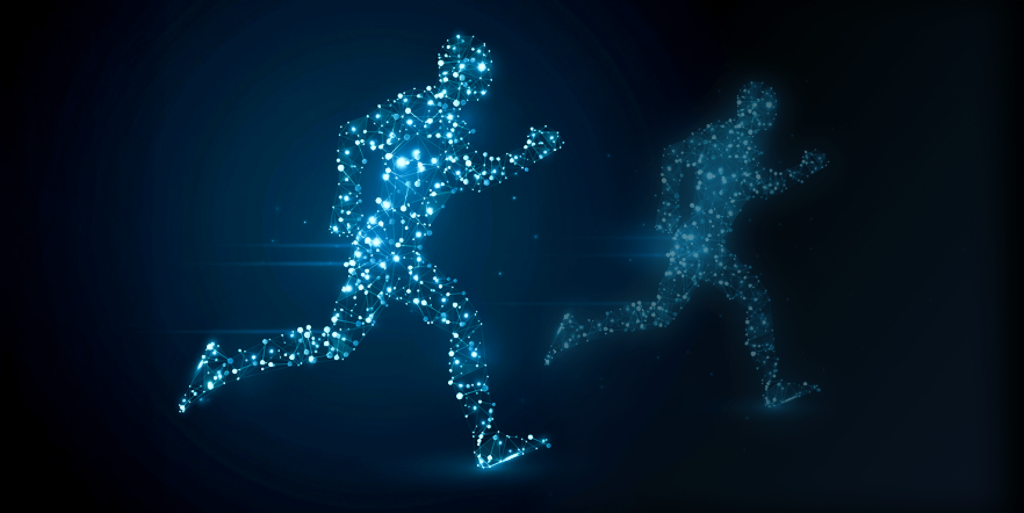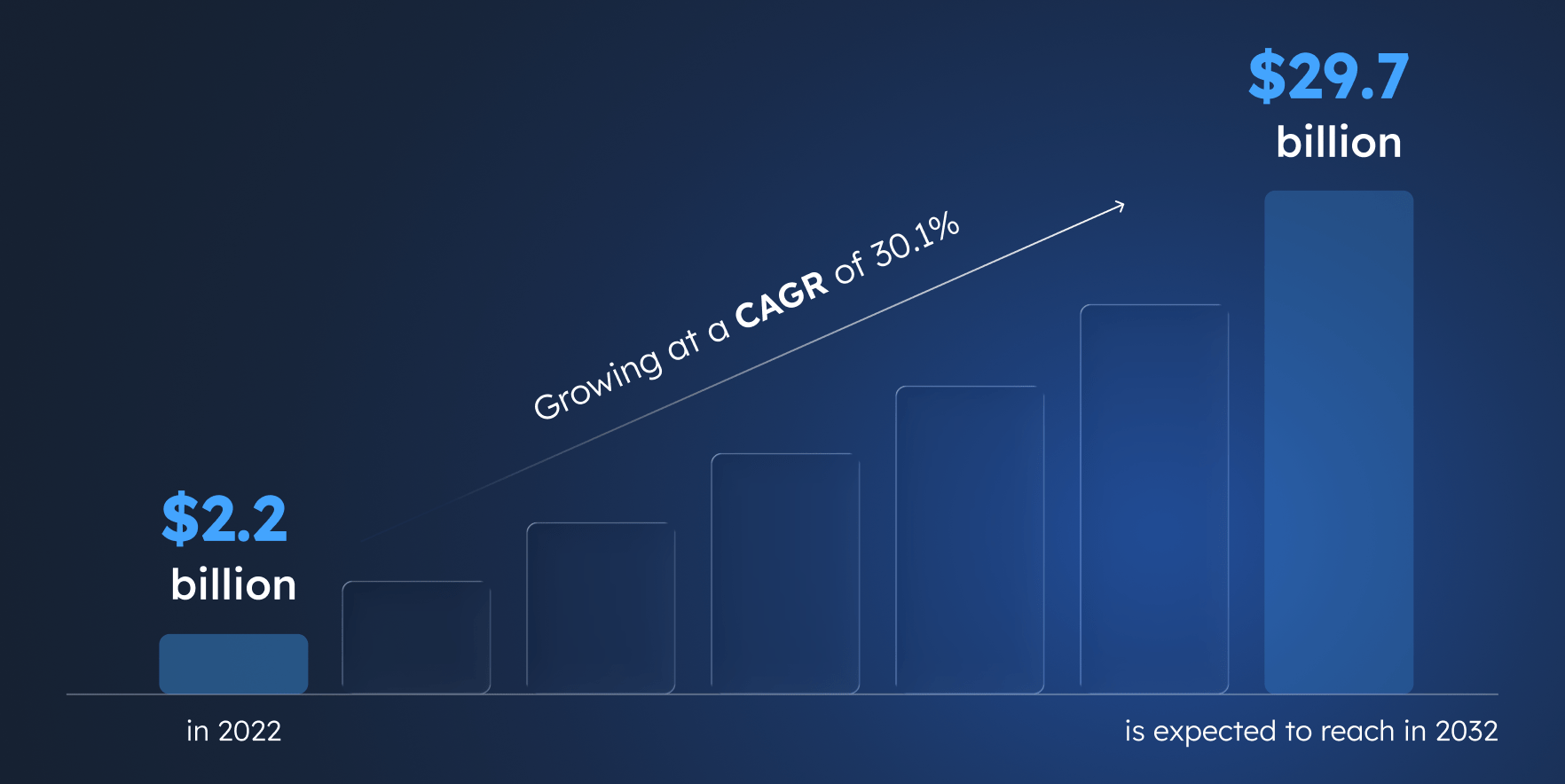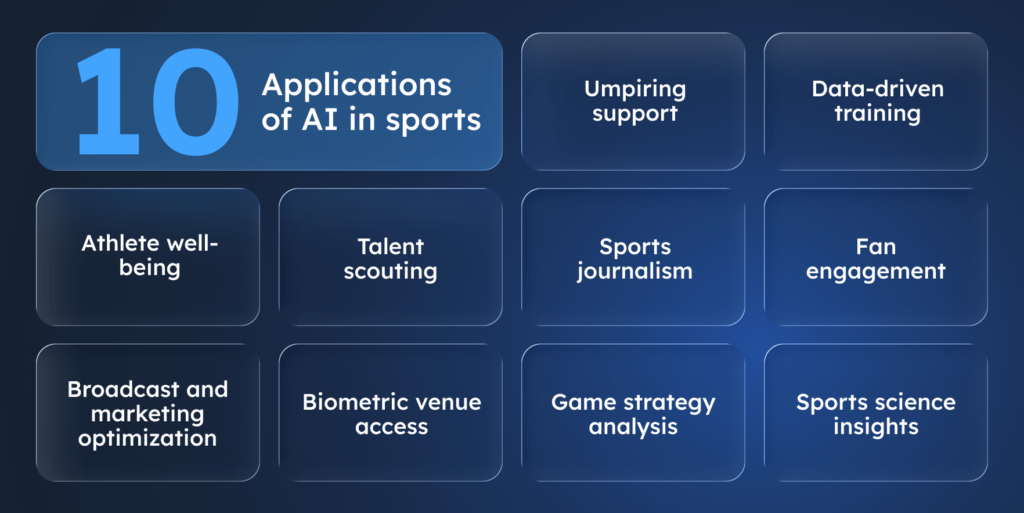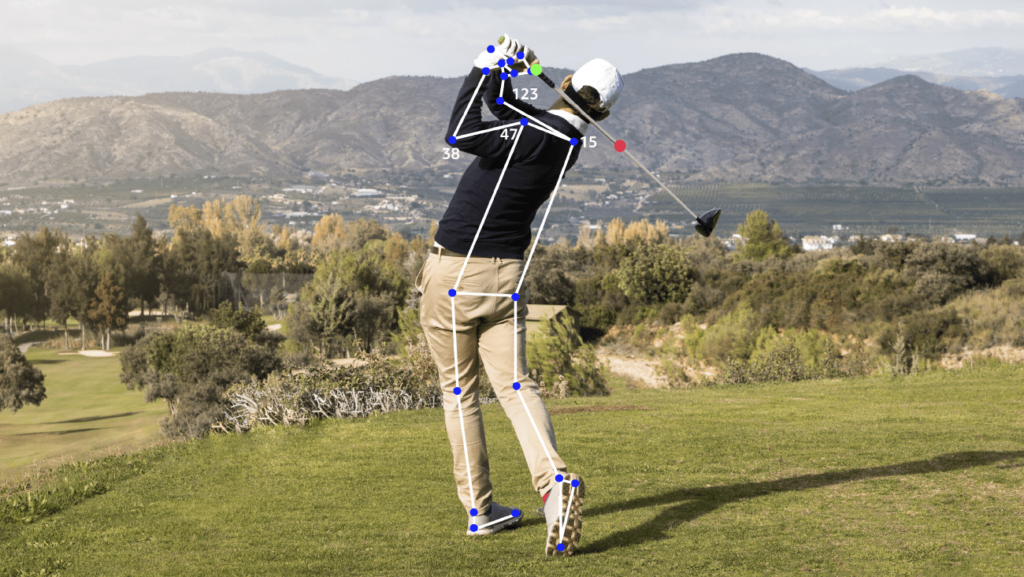Table of Contents
When talking about the use of artificial intelligence in sports, one of the first things that comes to mind, along with smart devices and sensors, is the “Moneyball” movie and its use of sabermetrics. Back in 2002, it helped evaluate players’ performance by using objective statistical measurements – and this sounds close enough to how AI helps evaluate one’s posture or behavior through object recognition today.
So, how does AI influence modern sports, and more importantly, will it replace some of its crucial elements that make games so enjoyable? Let’s find out.

AI in sports: trends and statistics
Artificial intelligence in sports has a dynamic, expanding market, especially in North America and the Asia-Pacific. It was estimated at $2.2 billion in 2022 worldwide and is expected to reach $29.7 billion by 2032, growing at a CAGR of 30.1%. Sports analytics is one of its most prominent segments, and is forecast to rise from $2.1 billion to $16.5 billion in 2020–2030.

AI in sports market growth, 2022–2032. Source
The key drivers of such rapid growth are the mass adoption of AI, ML, and big data among team managers and coaches; the broader use of real-time data; and the rising need for chatbots and virtual assistants to interact with fans and followers. Altogether, they aimed to maximize players’ potential and increase fans’ engagement.
The core restraints for AI project development resemble those businesses face in other domains: the lack of large, high-quality datasets, engineering talent scarcity, high execution and upkeep costs, as well as regulatory and ethical concerns. The unique challenges encompass limited collaboration between AI professionals and sports scientists and conflicts of interest among numerous stakeholders, which slow down technology adoption.
AI in sports industry: overview
Sports is a multifaceted industry that includes not only players, coaches, and managers, but also fans, broadcasters, journalists, and more. Overall, there are three main areas of AI application across the sports industry.
- Management and operations
- Media and fan experience
- Sports activities and game strategy
Management and operations include all processes related to sports events, but not to the game itself. These processes are venue management, ticketing, club and team management, sponsorship, and payments.
Media and fan experience includes content generation, betting, fan relationship management, and esports. It spans across the entire spectrum of how followers experience and participate in sport.
AI in sports games is best explained by dividing it into four segments.
- Talent selection and scouting. Screening and selecting the most suitable players based on their performance and AI-powered analysis.
- Pre-game preparation. Training and coaching, tactical and strategic game planning, injury prediction, and team assembly.
- In-game activities. The work of judges (calls, reviews, and VAR moments), coaching adjustments, and game analysis.
- Post-game activities. Game analysis, injury management, and recovery – all crucial for the future team operations and strategic planning.
As you can see, artificial Intelligence can be successfully used throughout the lifecycle of a sports event and caters to the needs of all parties involved, including not only the team and the coach but also fans and venue owners.
Another question is how exactly technology and sports software can be used in all these activities. Given that AI spans many subdomains and is often used alongside other technologies, we collected its main applications in the industry.
- Machine learning for automated highlight generation
- IoT sensors for heart rate, speed, and fatigue monitoring
- Computer vision for tracking player movements and officiating assistance
- Deep learning for injury prediction and automatic action recognition
- Big data analytics for player efficiency evaluation
- Large language models for AI coaching assistants and chatbots
- Predictive analytics for computing win-loss probabilities and attendance forecasting
While there are dozens of examples of AI implementation in sports, below we’d like to focus on the biggest ones that already shape the world of sports.
Expert’s thoughts on AI in sports
Since the Moneyball era, sports have become increasingly computational. Individual creativity on the pitch now coexists with — and is often shaped by — data-driven decision-making. With the ability to collect vast amounts of real-time data for virtually any sport, it has become much easier to apply advanced statistical methods to model performance, refine tactics, and improve player selection.
I have experience teaching a course on Football Analytics, where we explore the historical evolution of computational methods in the sport. Today, we can account for factors as subtle as grass length when modelling match dynamics and evaluating individual player performance. A wide range of machine-learning techniques can be applied, particularly network-analysis methods, which are well-suited to sports characterized by collective play and dense patterns of interaction.
How AI is used in sports: 10 key use cases
AI works in sports in multiple ways, including professional sports, grassroots sports, fan engagement, esports, and even sports science. Here are 10 examples of how it transforms the industry.

1. AI for referees
Modern sports already see the wide use of technology for accurate decision-making when it comes to umpiring. VAR (video assistant referee), Hawk-Eye, and slow-motion replay are aimed at improving game judging through computer vision analysis. VAR, for example, involves three people working together to review decisions made by the central umpire. As for Hawk-Eye, this technology allows tracking the ball’s trajectory so a referee can make a correct decision about the athlete’s actions.
Moreover, AI comes into play in the form of smart wearables (i.e., glasses) or overhead cameras in order to help referees make real-time decisions during the game without the need to pause it. In this way, artificial intelligence can not only provide a detailed analysis of a needed action (i.e., a goal) but may even recommend referees on the decisions to be made.
Organizers use AI cameras as video assistant referees to enhance scoring accuracy and promote fair play. The technology is frequently applied in games like tennis, soccer, basketball, and volleyball, as well as in other sports such as martial arts, gymnastics, and swimming. In research on AI applications for judging in Taekwondo, videos from the 2024 Paris Olympics were reviewed. It showed that the model-based judgments were highly aligned with those of international referees, deviating in only 9 out of 241 cases. AI reduced the average review time by 81%, demonstrating its potential for further application.
2. Smart training
A balanced, personalized preparation impacts a player’s performance. From individual training plans to opponent strategy analysis, artificial intelligence offers vast capabilities for smart workouts and advanced planning.
The most common technology combination in training is AI plus IoT sensors and smart wearables, such as vests, insoles, bands, and athlete tracking pods. They help evaluate performance and develop custom training programs based on the metrics received. Such plans consider muscle fatigue, training load, energy discharge, and other factors to achieve better results, avoiding under- and overloads.
For example, Liverpool FC used the Zone7 AI platform to optimize athletes’ performance through biometric, training, stress, and sleep data. It helps calculate future loads for elite athletes by adjusting intensity, rest, and workouts.
AI cameras for sports can be used for athletic development as well. They allow coaches and sports professionals to capture and analyze the movement mechanics and get instant feedback and advice on their improvement. Similarly, automatic game footage analysis can unveil player tendencies, improve strategy, positioning, and situational awareness.
3. Athlete well-being
With the help of computer vision and machine learning technologies, specialized applications can analyze a player’s physical condition and overall well-being, and suggest recommended diet plans and development opportunities. Here are the training areas that AI can cater to:
- Nutrition. Creation of personalized meal plans based on the goals and one’s current condition. For example, apps with computer vision can analyze products using the camera and immediately display their nutritional values and recommendations.
- Mental health. A career in sports is fraught with stress and tension. AI-powered apps can greatly contribute to emotional regulation and help keep one’s stress levels low. This is often overlooked in the industry, yet it is a common phenomenon in elite sports.
- Injury prevention and management. By analyzing one’s current state and their movements/posture, an AI-powered app can provide personalized recommendations on how to minimize or mitigate possible injuries caused by high-risk motions or overtraining.
- Recovery. AI assists in developing individual recovery programs and tracks the process, adjusting exercises and loads during rehabilitation to prevent relapse. Moreover, predictive modeling can be used to assess readiness for a safe return to play.
In contact-intensive sports like rugby and boxing, where the risk of concussion is high, AI has been used to monitor and identify impacts, automatically assessing their severity. For example, the NFL partnered with Amazon Web Services to develop an AI-based injury prediction tool called Digital Athlete. The solution will use players’ training and game records from all 32 teams to identify which players are more likely to be hurt and mitigate injury risks.
4. Scouting and talent search
Going back to the “Moneyball” movie, Billie Beane was signing undervalued players, and his scouting decisions were based solely on the sabermetrics. And as it turned out, his approach brought the Oakland Athletics (and later the Red Sox) many victories.
Today, scouting can be significantly facilitated by using AI for analyzing the player’s potential and predicting how they’ll perform in a game. First, computer vision tracks the player’s movements and identifies their strongest and weakest areas. Predictive analytics then makes forecasts based on collected data, allowing scouts to predict how athletes will perform in the future. This way, scouts can find rising stars earlier, predict the success of talent prospects, better understand which roles to assign to which players, and, overall, assemble robust, skilled teams.
We can take Spanish Sevilla FC as an example. They partnered with IBM to develop a Scout Advisor AI tool to support player recruitment processes with data. The solution processes both structured and unstructured data and creates curated candidate lists based on scouts’ requests.
5. AI-powered journalism
Fans crave content related to their favorite teams, but unfortunately, human journalists are physically unable to cover all local games and all events happening. Considering the fact that matches and competitions are held on a daily basis, a huge part of games remains uncovered and ignored in favor of bigger matches.
This can be fixed with artificial intelligence. AI-powered platforms like Wordsmith can quickly translate structured data (e.g., statistics or scores) into narratives, and, overall, AI can generate natural-like text that can be presented to readers. Inspired by technology capabilities, media agencies are actively experimenting with it. For example, the Entertainment and Sports Programming Network (ESPN) announced in 2024 that it would use AI-generated recaps for underrepresented sports, providing fans with previously unavailable content.
Of course, AI-written text will lack the individual touch of the writer and may not be as engaging. On the other hand, such texts are highly similar to, or even unrecognizable from, the ones people write, and the use of AI in journalism will allow for covering even the smallest games and local plays. And that’s something many fans will actually be delighted to see. Unsurprisingly, the global audience questions the quality and reliability of such content, so there should be editorial oversight over any generated text to avoid bias and faulty information.
6. Fan experience
The fan community is as crucial to the sports industry as players, so a great spectator experience is vital. According to the IBM report, 35% of sports fans said they value real-time game updates powered by artificial intelligence, while 30% highlighted personalized content as the main benefit of AI use in sports. The survey also shows that the followers stay enthusiastic about AI use in sports. So, what are the advancements for today?
First, there are smart chatbots that immediately provide users with information across a wide range of topics, from player info to stadium logistics. Some AI assistants even have augmented reality features, so users can easily identify hotspots and key players in real time. They provide instant, scalable support and cater to the global audience – no language barriers, just enhanced fan experience.
The main AI chatbot capabilities in sports include:
- Refunds and rescheduling support;
- Gives real-time updates on scores, lineups, and player stats;
- Recommends tickets, merchandise, or subscription;
- Delivers personalized notifications;
- Track fan behavior and preferences for marketing.
Second, there are smart video highlights that are aimed at identifying the most exciting and interesting games and showing them to fans, thereby increasing engagement. In contrast, manual analysis of games and hand-picking of the most intense ones takes too much time, and sometimes it’s hard to select games that draw the most attention.
With the help of AI, it is now possible to analyze games based on crowd noise or players’ emotions to select the best highlights and show the most relevant content to users. In addition, such AI-powered analysis significantly expands game coverage, as it may include highlights of lesser-known games that are still enjoyable to watch.
The English Premier League’s collaboration with Microsoft shows how technology for fan engagement is used in practice. The partnership is aimed at integrating Copilot into the league’s digital channels so fans can quickly find statistics and facts about matches. The project implies using data from the last 30 seasons, as well as 300,000 articles and 9,000 videos.
7. Broadcasting and marketing
Fans in sports are one of the primary sources of income for businesses in the industry, including teams, facilities operators, and broadcasters. From match tickets sold to merchandising and media platforms subscriptions – every dollar counts.
For broadcasting services, AI creates highlights from different spots based on media rights-holders’ preferences, streamlines content licensing and sales, and facilitates monetization. It enhances followers’ engagement, connecting them via dedicated platforms with live commentary and detailed updates in various languages. Whether it is personalized stats, replays, or highlights recommendations, specialized digital channels can offer relevant articles, documentaries, or collectibles based on a fan’s previous interactions. The result: more upselling, personalized advertising, and new revenue streams, such as NFTs.
Furthermore, AI for sports automates repetitive tasks, such as user-generated content moderation, customer support, and quick resume analysis. It makes followers’ experience more accessible and enjoyable, allowing them to watch events globally. For instance, Formula 1 uses predictive analytics to learn which content is most preferred and engaging for fans during races. It also helps explain race complexities to new fans, thereby attracting more viewers.
8. Ticketing with biometric recognition
Venue entry delays are among the biggest challenges facility owners face. If you need an example, search for Southampton FC refunding fans in 2021. As there is always a crowd at the entry, it can be difficult to check their tickets and perform security scans quickly.
Biometric recognition (e.g., face recognition) can significantly speed up the ticketing process by instantly scanning the visitor’s face and matching it to a photo in the database. In this way, venue owners can minimize or prevent pre-match entry bottlenecks and enhance fan experience.
For example, Argentina’s football club River Plate has implemented a biometric ticketing system at its home stadium, which has a capacity of 85,000. The technology allows contactless and secure verification of game-goers’ identities on the fly. When buying a ticket, a fan can upload their selfie and attach an ID document to be instantly recognized and fast-tracked through the gates without waiting in lines.
In addition, computer vision at stadiums can analyze crowd density and notify employees if a particular area needs attention. It can enhance security as well by verifying staff entering the sensitive areas, like fields or warm-up zones, during the game.
9. Game strategy
AI can significantly improve game strategies by analyzing data from previous matches and building predictive models for adjusting the main game plan. For example, the algorithm can simulate different scenarios and assess chances of success, enabling the team to maximize its strengths and gain an advantage. Sports analytics tools like xG, enhanced by machine learning, can evaluate a team’s in-game performance, analyze whether it creates good chances, and help avoid overreacting to random outcomes.
GPS tracking systems and cameras, combined with artificial intelligence, contribute to strategy optimization by detecting teams’ and opponents’ forward passes, penalty kicks, and corners. Based on this information, the model can then suggest in-game tactical adjustments and quickly react to the unforeseen match dynamics.
When it comes to real-life examples, Liverpool FC is in the spotlight again. Their TacticAI assistant advises coaches on corner kicks, demonstrating 90% approval among human experts. The model uses predictive/generative AI and geometric deep learning to predict the outcomes of the opponent’s corner kicks and to develop counter-tactics.
10. Sports science
In sports science, AI helps process large datasets in biomechanics, physiology, and the environment, uncovering new relationships between training variables and performance. It assists in examining movement patterns and biomechanics in great detail, simulates training, and models physiological responses to predict an athlete’s energy expenditure and cardiovascular responses. The main goal here is to find the balance between optimal performance and injury risks, which go hand in hand.
The shift from traditional statistical models says it all: AI systems lead to a 23% reduction in reinjury rates, 96.8% accuracy in archer’s motion detection for assessment of biomechanical stability, and 78% accuracy in hamstring strain injury prediction. Science continues to provide the sports industry with forecasts, explanations, and recommendations. It enables coaches, physiotherapists, and sport scientists to base their interventions on evidence rather than mere intuition or experience.
A case from SoftTeco: a Golf Club application
SoftTeco has worked on an AI project for a golf club manufacturer. It aimed to analyze golf players’ postures and strokes to design individual golf clubs. The client already used computer analysis to learn how players moved during the game. However, the work was semi-manual. The company reached out to SoftTeco to fully automate posture estimation and stroke analysis.
Our team designed an application that uses two AI models. The first was created to detect the player’s position and their club’s position. The second was built to segment the club image from its surroundings. With their help, the app collects various metrics and delivers accurate results that the client later uses for designing individual sports equipment. Custom-made clubs, in turn, contribute to better performance, as they fully fit players based on their physical parameters.


Are we starting to lose human element in sports?
While AI seems to make umpiring more accurate and provides smart training plans for players, do we really need AI to invade all areas of the sports industry?
For many long-time fans, passing through a turnstile is an essential part of the whole fan experience, starting the moment a fan enters a venue. Besides, almost all fans anticipate those precious moments when a referee has to make a critical decision or when a minor human factor turns out to be the deciding factor for the game outcome.
So is AI making sports too sterile and predictive? Is it taking away the joy of not knowing what will happen next in terms of the game outcome and final scores? Probably yes, and such concerns should be taken into consideration. Maybe the best-case scenario is to use AI in sports to assist, not replace certain processes, and leave the human element intact. After all, it’s those small imperfections that make millions of people around the world hold their breath when watching their favorite game.
Final thoughts
AI development has brought many innovations to the sports industry, from athletes’ performance to injury prevention and event media coverage. Yet, with so many ways technology can help to make matches more spectacular and profitable, athletes, coaches, and physiotherapists should consider its recommendations critically, applying contextual knowledge and human experience.
While AI facilitates coaching, improves players’ well-being, and makes the fan experience even more enjoyable, there are still concerns about ethical use of data, technical challenges, and implementation costs. SoftTeco is an experienced AI software partner with responsible and ethical data practices and transparent pricing. Contact us if you need a free consultation on your project.


Comments